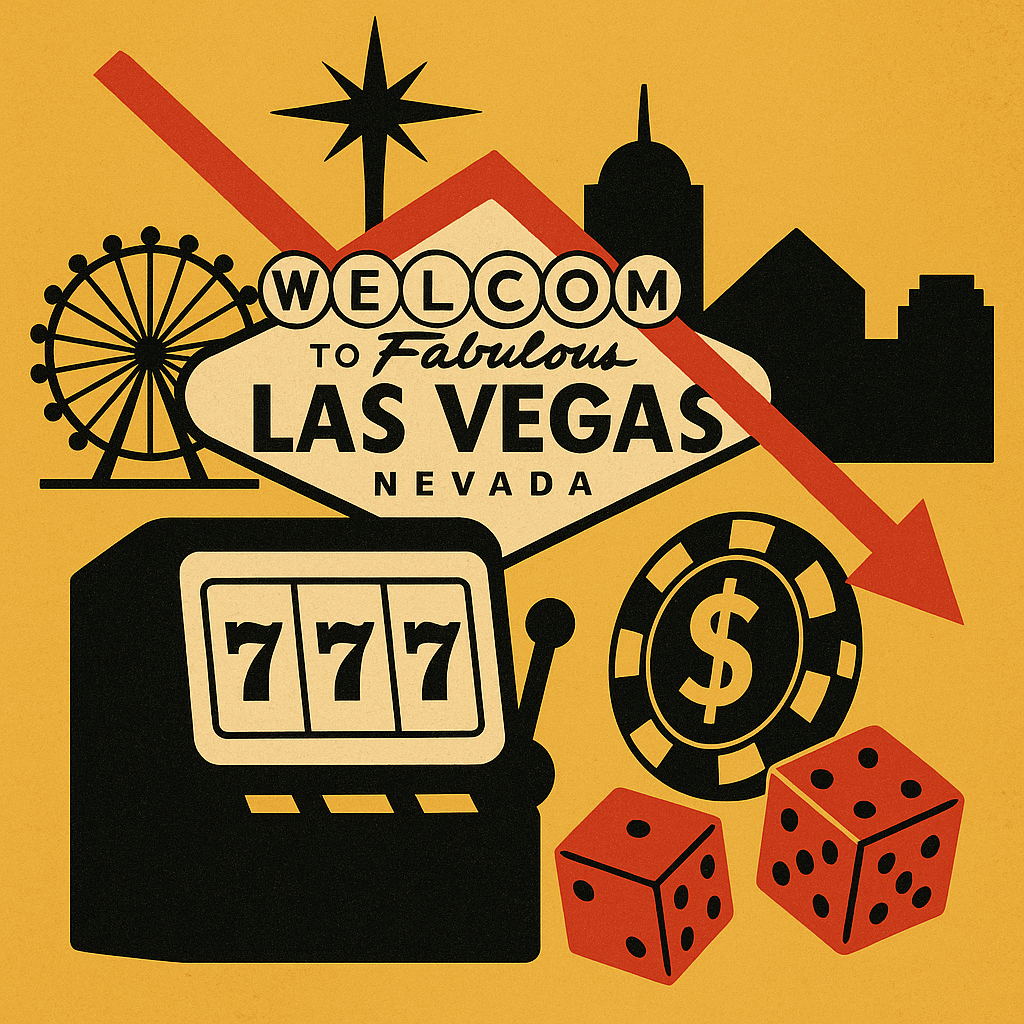
Neon Mirage: How Vegas Gambled Away Its Magic
Las Vegas built its empire on one seductive promise: the chance to feel bigger than your paycheck, at least for a weekend. For decades, Americans and international travelers alike treated Sin City as the adult Disneyland, a place where disposable income and common sense went to die under neon lights. But today, the house that gambling built is losing its edge.
Visitor numbers fell 11% year-over-year in June 2025, the sixth straight month of decline, according to the Las Vegas Convention and Visitors Authority. Convention traffic, once a reliable lifeline for the city’s sprawling resorts, is also down 11%. International visitors, a critical growth engine, have dropped 13%. The Strip is emptier, and the reasons why read like a cautionary tale for any business resting on nostalgia.
The Mirage of Unlimited Growth
Las Vegas bet too hard on its own mythology. When you charge customers $50 a night in resort fees, $20 cocktails, and give them fewer perks than their parents enjoyed in the ‘90s (remember $5 prime rib dinners?), you are no longer offering escape. You are offering insult.
It is Marketing 101: when your value proposition evaporates, loyalty does too. Deloitte’s 2025 summer travel survey shows Americans are cutting back vacation budgets in the face of inflation and economic anxiety. Instead of “what happens in Vegas stays in Vegas,” consumers are opting for cheaper, more authentic leisure experiences such as national parks, road trips, or international destinations where the dollar stretches further.
For Vegas, the assumption was always that people would pay whatever price the Strip demanded because the city was irreplaceable. That assumption is proving fatal.
Death by Commoditization
Here’s the hard truth: the Vegas model has been commoditized. Gambling? It’s on your phone. Live shows? Available on streaming platforms or in any major city. Michelin-star dining? Name a U.S. metro that doesn’t have it. Even sports, with the city’s recent play with the Raiders, Golden Knights, and Formula 1, are not unique hooks anymore.
Vegas stopped being a singular experience and instead became just another overpriced entertainment district. This is the same trap legacy retailers like Sears and JCPenney fell into: mistaking brand familiarity for brand indispensability.
The Politics of Decline
International tourism used to prop up the Strip when domestic demand softened. But political turbulence has slammed that door. Canadian tourists, the single largest foreign group visiting Vegas, are now skipping the trip south. Tariffs, political insults, and the rising cost of living have all cooled the cross-border romance. The city’s reliance on international traffic, once a strength, has become a glaring vulnerability.
It’s a reminder for marketers everywhere: do not let one customer segment become your lifeline. Diversification in audiences is just as critical as diversification in revenue streams.
Vegas’ Marketing Blind Spot
At its peak, Vegas was a masterclass in branding. “What happens in Vegas, stays in Vegas” was not just a slogan. It was a cultural permission slip. It turned a weekend trip into a rite of passage. But when the brand no longer matched reality—when bachelor parties were priced out, when the thrill of gambling could be replicated in a DraftKings app—Vegas did not pivot.
Instead, the city doubled down on squeezing margins: higher fees, lower perks, and the assumption that star power alone could fill hotel towers. Marketing cannot patch over a broken business model. If the experience fails, the story collapses.
Businesses outside Vegas should take note: no brand is too big to fail if it stops evolving with its customers. Kodak learned it. Blockbuster learned it. Vegas is now taking that class in real time.
The False Salvation of Big Events
Optimists point to the F1 Las Vegas Grand Prix, the 2026 FIFA World Cup, and a revolving door of residency concerts as signs of life. But this is patchwork growth. Big events spike revenue temporarily; they do not fix structural rot. Depending on them is like a retailer betting on Black Friday to cover an entire fiscal year.
Vegas is not dying because it lacks marquee events. It is dying because the everyday experience of being there feels more like being hustled than being entertained.
What Businesses Can Learn from Vegas’ Decline
Vegas may or may not stage a comeback (the city has nine lives), but its current slump offers powerful lessons for any brand:
- Do not confuse pricing power with customer love. You can raise fees until customers notice they are being exploited. When they do, recovery is hard.
- Keep the core value alive. Vegas was built on escapism and indulgence, but now it feels transactional. Businesses must constantly refresh what makes them special.
- Diversify your growth engines. Relying too heavily on conventions, international visitors, or any single audience is a recipe for fragility.
- Branding is not a bandaid. No slogan can save an experience that is out of step with consumer needs. The story must align with the product.
- Events are not strategy. Spikes are great, but sustainable growth comes from delivering everyday value, not banking on once-a-year fireworks.
Will Vegas Rise Again?
Of course, Vegas is not vanishing overnight. The city is too entrenched in American culture, too wired into entertainment infrastructure, and still has billions in sunk costs to leverage. But survival is not the same as thriving.
If the Strip wants to avoid becoming a relic, a desert Disneyland no one under 40 cares to visit, it will need to reinvent itself. That means ditching predatory pricing, rediscovering what makes the city magical beyond neon excess, and creating experiences people cannot replicate from their phones.
The real gamble now is not at the blackjack table. It is whether Vegas can rebrand itself before the next generation of travelers cash out.
Related reading: Hawke Media’s take on brand storytelling and customer experience.